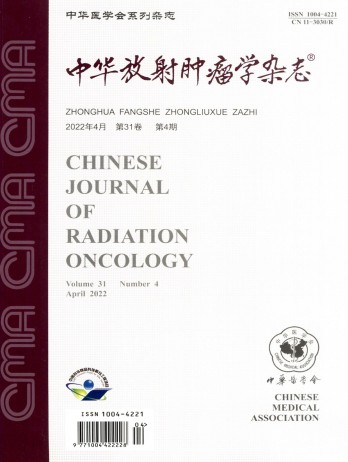改良根治性乳房切除术后T1-2N1乳腺癌症局部复发的失败模式
引用次数: 0
摘要
目的分析改良根治性乳房切除术后T1-2N1乳腺癌局部复发(LRR)的失败模式及放疗范围。方法1997年9月至2015年4月,在我院对2472例癌症T1-2N1乳腺癌患者行改良根治性乳房切除术,无需新辅助系统治疗。1898名未接受辅助放射治疗的患者被纳入本研究。分析了累积LRR的分布。采用Kaplan-Meier方法估计LR和RR发生率,并采用Log-rank检验在单变量分析中确定预后因素。采用Cox逻辑回归分析进行多变量分析。结果164例患者中位随访71.3个月(1.1-194.6),其中锁骨上/锁骨下淋巴结106例(65%),胸壁69例(42%),腋窝39例(24%),乳内淋巴结19例(12%)。在多变量分析中,年龄(>45岁vs.≤45岁)、肿瘤位置(其他象限vs.内象限)、T分期(T1vs..T2)、腋窝淋巴结阳性数(1 vs.2-3)、激素受体状态(阳性vs.阴性)是LR和RR的重要预后因素。结论改良根治性乳房切除术后T1-2N1乳腺癌症患者最常见的LRR部位为锁骨上/锁骨下结区,其次为胸壁。腋窝或IMN复发是罕见的。LR和RR的预后因素相似,这表明应考虑锁骨上/锁骨下和胸壁照射进行骨切除术后放疗。关键词:乳腺肿瘤/改良根治性乳房切除术;阳性淋巴结;局部复发模式本文章由计算机程序翻译,如有差异,请以英文原文为准。
Failure patterns of locoregional recurrence in women with T1-2N1 breast cancer after modified radical mastectomy
Objective
To analyze the failure patterns of locoregional recurrence (LRR) and investigate the range of radiotherapy in T1-2N1 breast cancer patients undergoing modified radical mastectomy.
Methods
From September 1997 to April 2015, 2472 women with T1-2N1 breast cancer after modified radical mastectomy without neoadjuvant systemic therapy were treated in our hospital. 1898 patients who did not undergo adjuvant radiotherapy were included in this study. The distribution of accumulated LRR was analyzed. The LR and RR rates were estimated by the Kaplan-Meier method, and the prognostic factors were identified in univariate analyses with Log-rank test. Multivariate analysis was performed using Cox logistic regression analysis.
Results
With a median follow-up of 71.3 months (range 1.1-194.6), 164 patients had LRR, including supraclavicular/infraclavicular lymph nodes in 106(65%), chest wall in 69(42%), axilla in 39(24%) and internal mammary lymph nodes (IMNs) in 19 patients (12%). In multivariate analysis, age (>45 years vs.≤45 years), tumor location (other quadrants vs. inner quadrant), T stage (T1vs. T2), the number of positive axillary lymph nodes (1 vs. 2-3), hormone receptor status (positive vs. negative) were significant prognostic factors for both LR and RR.
Conclusions
In patients with T1-2N1 breast cancer after modified radical mastectomy, the most common LRR site is supraclavicular/infraclavicular nodal region, followed by chest wall. The axillary or IMN recurrence is rare. The prognostic factors for LR and RR are similar, which indicates that supraclavicular/infraclavicular and chest wall irradiation should be considered for postmastectomy radiotherapy.
Key words:
Breast neoplasm/modified radical mastectomy; Positive lymph node; Locoregional recurrence patterns
求助全文
通过发布文献求助,成功后即可免费获取论文全文。
去求助
来源期刊
自引率
0.00%
发文量
6375
期刊介绍:
The Chinese Journal of Radiation Oncology is a national academic journal sponsored by the Chinese Medical Association. It was founded in 1992 and the title was written by Chen Minzhang, the former Minister of Health. Its predecessor was the Chinese Journal of Radiation Oncology, which was founded in 1987. The journal is an authoritative journal in the field of radiation oncology in my country. It focuses on clinical tumor radiotherapy, tumor radiation physics, tumor radiation biology, and thermal therapy. Its main readers are middle and senior clinical doctors and scientific researchers. It is now a monthly journal with a large 16-page format and 80 pages of text. For many years, it has adhered to the principle of combining theory with practice and combining improvement with popularization. It now has columns such as monographs, head and neck tumors (monographs), chest tumors (monographs), abdominal tumors (monographs), physics, technology, biology (monographs), reviews, and investigations and research.

 求助内容:
求助内容: 应助结果提醒方式:
应助结果提醒方式:


